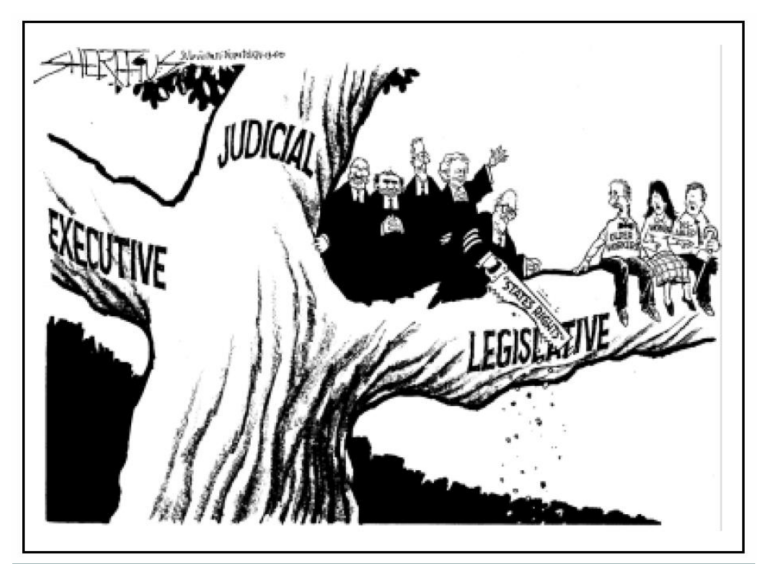national government. - Doral Academy Preparatory

Federalism
Essential Question
How does power flow through our federal system of government?
Federalism Activity
Defining Federalism
What is Federalism?
A way of organizing a nation so that two or
more levels of government have formal authority over the land and people.
Division and sharing of power between levels of government
Intergovernmental Relations
The workings of the federal system- the entire set of interactions among national, state
and local governments.
Defining Federalism
Types of POWERS
Expressed (enumerated)
Implied (necessary and proper)
Inherent “assumed” (acquisition of territory, foreign affair)
Reserved (States only)
Concurrent (shared)
Why is Federalism So Important?
Decentralizes our politics
More opportunities to participate
Electoral system
Decentralizes our policies
Which government should take care of which problem?
States can solve the same problem in different ways.
The Constitutional Basis of Federalism
The Division of Power
Supremacy Clause (VI)
The U.S. Constitution
Laws of Congress
Treaties
State Constitutions
State Laws
10 th
Amendment:
State’s Rights
What gives the federal government more power!
The Constitutional Basis of Federalism
The Constitutional Basis of Federalism
Establishing National Supremacy
Implied Powers
Commerce Powers
The Civil War
The Struggle for Racial Equality
The Constitutional Basis of Federalism
States’ Obligations to Each Other
Full Faith and Credit Clause
Defense of Marriage Act 1996 (not included)
Extradition
Privileges and Immunities
Federalism Group Activity
Get in groups of 3
Task: Your group will examine three case
studies in which either the national government or a state government faced conflict in exercising its powers.
After examining the facts and arguments, your group will determine whether, according to the U.S. federal system, a legitimate use of power exists.
Case Study # 1: Federalism and Gun Control Laws
What interesting details do you see?
What federalism issue do you think this photograph represents?
Do you think the national government or the state governments should have the power to control guns near schools?
Case Study # 1: Federalism and Gun Control Laws
Read the Case Study.
Discuss within your groups and answer the questions at the bottom.
Do you think the national government has the power to prohibit the possession of firearms near schools?
Why or why not?
Case Study # 1: Federalism and Gun Control Laws
Case Study # 2: Federalism and Tobacco Advertising
Laws
What interesting details do you see?
What federalism issue do you think this photograph represents?
Do you think the national government or the state governments should have the power to regulate cigarette advertising?
Case Study # 2: Federalism and Tobacco Advertising Laws
Read about federalism and tobacco advertising laws on Student Handout
B.
Do you think
Massachusetts has the power to regulate tobacco advertising within its borders?
Case Study # 2: Federalism and Tobacco Advertising Laws
Case Study # 3:
Federalism and Air Pollution Laws
What interesting details do you see?
What federalism issue do you think this photograph represents?
Do you think the national government or the state governments should have the power to limit air pollution?
Case Study # 3:
Federalism and Air Pollution Laws
Read article and discuss questions with group!
Case Study # 3:
Federalism and Air Pollution Laws
Outcome of Alaska Department of Environmental
Conservation v. EPA
On January 21, 2004, the Supreme
Court decided that the
Environmental Protection Agency had the power to regulate air pollution in Alaska. In a 5-4 decision, the Court stated,
the Clean Air Act gave the EPA the authority to override a state’s decision.
• the EPA had enough evidence to reject Alaska’s claim that the state had required the best control technology available.
Post-Activity Discussion
Intergovernmental Relations Today
Dual Federalism
A system of government in which both the states and the national government remain supreme within their own spheres , each responsible for some policies.
Like a layer cake
Ended in the 1930’s
Intergovernmental Relations Today
Cooperative Federalism
A system of government in which powers and policy assignments are shared between states and the national government .
Shared costs
Shared administration
States follow federal guidelines
Intergovernmental Relations Today
Intergovernmental Relations Today
Fiscal Federalism
The pattern of spending, taxing, and providing grants in the federal
system; it is the cornerstone of the national government’s relations with state and local governments.
$600 Billion
Figure 3.2
Intergovernmental Relations Today
Federal Grants to State and Local Governments (Figure 3.1)
Intergovernmental Relations Today
The Grant System
Categorical Grants: grants used for specific purposes with strings attached.
Types of Categorical Grants
1.
Project Grants: based on merit , competition (most common)
2.
Formula Grants: amount varies based on formulas
Block Grants: Federal grants given more or less automatically
to support broad programs.
Grants are given to states & local governments
Intergovernmental Relations Today
Fiscal Federalism continued
The Scramble for Federal Dollars
$400 billion in grants every year
Universalism - a little something for everybody
The Mandate Blues
Mandates direct states or local governments to comply with federal rules under threat of penalties or as a condition of receipt of a federal grant.
Unfunded mandates are requirements on state & local governments - but no money
Understanding Federalism
Advantages
Increasing access to government
Local problems can be solved locally
Hard for political parties / interest groups to dominate ALL politics
Disadvantages
States have different levels of service
Local interest can counteract national interests
Too many levels of government - too much money
What are the benefits and drawbacks of a federal system?
Understanding Federalism
State Welfare Benefits (Figure 3.3)
Understanding Federalism
Spending on Public Education (Figure 3.4)
Understanding Federalism
Understanding Federalism
Federalism and the Scope of Government
Which level of government is best able to solve the problem?
Which level of government is best able to fund solutions to the problem?







